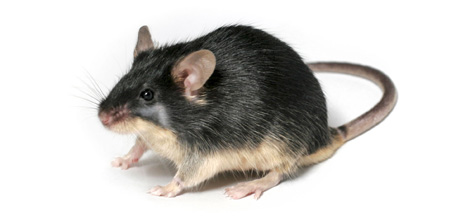In February 2007, the Centers for Disease Control and Prevention reported that the prevalence of autism had risen to one in every 150 American children, and almost one in 94 boys. The news was not surprising to the Autism Society of America (ASA) — nor to the 1.5 million Americans living with the effects of autism. Autism is a complex developmental disability that affects a person's ability to communicate and interact with others. Generally, it appears during the first three years of life. The lifetime cost of caring for a child with autism ranges from $3.5 million to $5 million (ASA). There is no known single cause. Recent research with JAX® Mice strain BTBR T+ tf/J (BTBR, 002282) may shed light not only on the environmental but on the genetic causes of autism.
 JAX® Mice Strain BTBR T+ tf/J (002282) may shed light on the genetic causes of autism.
JAX® Mice Strain BTBR T+ tf/J (002282) may shed light on the genetic causes of autism.
A group of researchers from the NIH Laboratory of Behavioral Neuroscience and the Department of Cell Biology and Neurosciences, Istituto Superiore di Sanita', Rome, recently found that atypical vocalizations of BTBR pups (e.g. absence of crying and unusual guttural grunts and squeals) separated from their mothers may be analogous to those of some infants later diagnosed with autism (Scattoni et al. 2008).
When separated from their mothers, mouse and rat pups emit ultrasonic vocalizations (USVs), which prompt the mothers to retrieve them, lick them and crouch, suggesting that the calls play an important role in social communication between mother and infant. The authors hypothesized that abnormal USVs in mice may be signs of impaired communication and the development of autism. BTBR mice display several autism-like traits, including reduced social approach in adults, reduced reciprocal social interactions in juveniles and adults, decreased social transmission of food preference, and high repetitive self grooming.
To determine if BTBR mice also display communication deficits, and if autism-like phenotypes in mice can be detected at early developmental stages, the researchers compared neonatal USV patterns and behavioral and somatic development in BTBR pups throughout the first two weeks of life to those of three control strains typically used in behavioral genetics and as backgrounds for breeding genetically modified mice: C57BL/6J (000664). FVB/NJ (001800), and 129X1/SvJ (000691). They found that BTBR mice have an unusual pattern of vocalizations, emit only four out of 10 categories of calls assayed, display abnormally frequent and loud harmonics, and grow and develop more quickly than controls.
These findings may be an important step in helping researchers determine the environmental and genetic bases and in developing therapies for an increasingly prevalent neurodevelopmental disease.
Reference:
Scattoni ML, Gandhy SU, Ricceri L, Crawley. 2008. Unusual repertoire of vocalizations in the BTBR T+ tf/J mouse model of autism. PLoS ONE 3:e3067.
Other JAX® Mice strains useful for studying autism:
B6;129-Gabrb3tm1Geh/J 002711
B6;129S2-En2tm1Alj/J 002657
B6;129X1-Avpr1btm1Wsy/J 006160
B6;129-Nlgn3tm2.1Sud/J 008394